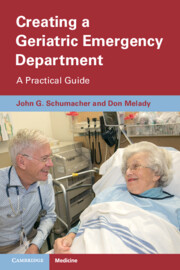Book contents
- Creating a Geriatric Emergency Department
- Creating a Geriatric Emergency Department
- Copyright page
- Dedication
- Contents
- Acknowledgments
- Introduction
- Chapter 1 Making the Case for a Geriatric Emergency Department
- Chapter 2 Starting a Geriatric Emergency Department
- Chapter 3 Overcoming Resistance: What to Do with “Yeah, But…”
- Chapter 4 You: An Approach to Your Older Emergency Department Patients
- Chapter 5 People: Adding Staffing and Training
- Chapter 6 Processes: Implementing Protocols and Policies
- Chapter 7 Place: Addressing the Physical Environment
- Chapter 8 Quality Improvement in the Geriatric Emergency Department: Getting Started
- Chapter 9 Launching Your Geriatric Emergency Department: From First Steps to Accreditation
- Appendix: Practical Resources and Links
- Index
- References
Introduction
Published online by Cambridge University Press: 20 January 2022
- Creating a Geriatric Emergency Department
- Creating a Geriatric Emergency Department
- Copyright page
- Dedication
- Contents
- Acknowledgments
- Introduction
- Chapter 1 Making the Case for a Geriatric Emergency Department
- Chapter 2 Starting a Geriatric Emergency Department
- Chapter 3 Overcoming Resistance: What to Do with “Yeah, But…”
- Chapter 4 You: An Approach to Your Older Emergency Department Patients
- Chapter 5 People: Adding Staffing and Training
- Chapter 6 Processes: Implementing Protocols and Policies
- Chapter 7 Place: Addressing the Physical Environment
- Chapter 8 Quality Improvement in the Geriatric Emergency Department: Getting Started
- Chapter 9 Launching Your Geriatric Emergency Department: From First Steps to Accreditation
- Appendix: Practical Resources and Links
- Index
- References
Summary
Overview of this practical guide helping practicing ED interdisciplinary clinicians, ED leaders, and hospital administrators who are responsible for providing acute care to older adults to improve their care.
Information
- Type
- Chapter
- Information
- Creating a Geriatric Emergency DepartmentA Practical Guide, pp. 1 - 3Publisher: Cambridge University PressPrint publication year: 2022
